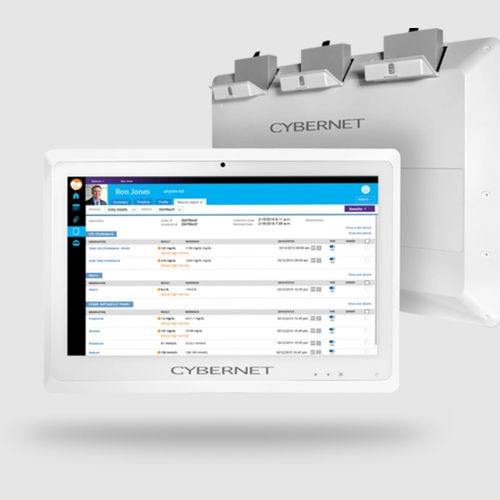
#Industry News
Beyond The Screen: A Comprehensive Guide to Privacy Filters In Healthcare Settings
Privacy filters are a key tool for protecting private health information from prying eyes.
When you say "cybercrime," the first image that comes to mind is often some shadowy, hooded figure hunched over a computer screen, typing away furiously for no apparent reason. In truth, cybercrime takes many forms, including what is known as "visual hacking."
Visual hacking is exactly what it sounds like: malicious actors spotting confidential information on a screen and memorizing or recording it for illicit use later on. This is especially troubling in the healthcare sector, where healthcare workers are often too busy to check if someone’s peeking over their shoulder and where private health data is full of information valuable for criminals.
Thankfully, there is a solution for prying eyes: a privacy filter built into the computer monitor that protects sensitive information being displayed on it.
What is a Privacy Screen?
Privacy screens, or privacy filters, are thin layers of polarized plastic that reduce the viewing angle of the screen they're attached to. This means that while someone facing the screen directly can view information without issue, anyone standing off to the side will only see an empty field of black.
When it comes to screen privacy, there are certain best practices that can be followed. Using partitions whenever possible and keeping screens out of public view are good ideas in theory, but hospital wards are frequently too crowded and busy to make these solutions practical. However, a privacy screen that attaches or is applied directly to the monitor sidesteps this issue.
These screens are made from plastics such as polycarbonate or acrylic and combine an anti-glare coating with angled slats and panels within the plastic's structure. This lets let pass through the plastic layer from certain angles, but not from others. No light means no outside observers can see the screen's contents.
How Can Privacy Screens Be Installed?
Several options exist for adding privacy filters to a monitor.
Attachable filters can be put on or taken off as employees need. These are helpful if employees frequently collaborate and more than one person will try to look at the screen simultaneously.
Permanent adhesives can be used to permanently attach a filter to the monitor in question. These are typically used on monitors that require extra protection at all times, such as medical-grade computers that constantly display sensitive information.
Privacy Screens For Medical Computers
There is one major concern for using privacy screens in healthcare environments: healthcare providers must constantly disinfect every surface, including the monitors of their computers, to prevent the spread of microbes.
Unfortunately, these disinfectants are extremely harsh chemicals and can damage or destroy the delicate plastic structures of the privacy filter, rendering it useless. Therefore, the best way to implement a privacy filter on a medical-grade computer or tablet is to place it inside the monitor, on the other side of the glass.
This makes it a permanent fixture but completely protects the filter from disinfectants. Remember, a medical-grade computer will have an IP (ingress protection) rating of at least 65, indicating it is dust-sealed and waterproof. This means that the privacy screen and the rest of the computer’s internal components will be protected no matter how much the computer’s monitor is cleaned.
Final Considerations For Privacy Screens
There are two final issues to consider when you're thinking about adding a privacy filter to your computer:
Viewing angle: This determines how broad an angle the screen’s contents are still visible. For most users, the default is 60 degrees. This gives the computer’s user a bit of leeway but obscures any would-be prying eyes.
Minimal effect on user experience: A good privacy screen shouldn’t affect the display’s quality. This is especially important in medical environments, which rely on spotting small details in the diagnostic or imaging stages of treatment.
Closing Thoughts
With the threat of cybercrimes ever more prevalent in the healthcare sector, healthcare groups must take whatever steps they can to protect the private health data of their patients. Fortunately, implementing privacy filters is one of the easiest ways to prevent one of the most common sources of data breaches.
If you’re curious about adding medical-grade computers with integrated privacy filters to your operation, contact the team at Cybernet Manufacturing. Our experience as an original equipment manufacturer allows us to add integrated privacy screens during manufacturing and assembly, giving you peace of mind during operations.





